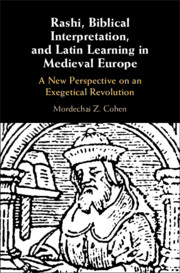 Rashi, Biblical Interpretation, and Latin Learning in Medieval Europe
Rashi, Biblical Interpretation, and Latin Learning in Medieval Europe Book contents
- Rashi, Biblical Interpretation, and Latin Learning in Medieval Europe
- Rashi, Biblical Interpretation, and Latin Learning in Medieval Europe
- Copyright page
- Dedication
- Contents
- Acknowledgments
- Abbreviations
- Introduction
- 1 A New Program of Peshat (“Plain Sense” Exegesis)
- 2 “Settling” the Words of Scripture Using Midrash
- 3 St. Bruno on Psalms: Precedent for Rashi?
- 4 Comparison to the Andalusian Exegetical School
- 5 Comparison to the Byzantine Exegetical School
- 6 Rashi’s Literary Sensibilities and Latin Grammatica
- 7 Rashi’s Notion of “the Poet” (ha-Meshorer) in the Latin Context
- 8 Joseph Qara and Rashbam: Peshat Legacy in Northern France
- 9 Literary Sensibilities of Peshat within a Latin Context
- Bibliography
- General Index
- Index of Scriptural References
- Index of Rabbinic Sources
6 - Rashi’s Literary Sensibilities and Latin Grammatica
Published online by Cambridge University Press: 15 April 2021
- Rashi, Biblical Interpretation, and Latin Learning in Medieval Europe
- Rashi, Biblical Interpretation, and Latin Learning in Medieval Europe
- Copyright page
- Dedication
- Contents
- Acknowledgments
- Abbreviations
- Introduction
- 1 A New Program of Peshat (“Plain Sense” Exegesis)
- 2 “Settling” the Words of Scripture Using Midrash
- 3 St. Bruno on Psalms: Precedent for Rashi?
- 4 Comparison to the Andalusian Exegetical School
- 5 Comparison to the Byzantine Exegetical School
- 6 Rashi’s Literary Sensibilities and Latin Grammatica
- 7 Rashi’s Notion of “the Poet” (ha-Meshorer) in the Latin Context
- 8 Joseph Qara and Rashbam: Peshat Legacy in Northern France
- 9 Literary Sensibilities of Peshat within a Latin Context
- Bibliography
- General Index
- Index of Scriptural References
- Index of Rabbinic Sources
Summary
Precedents for various aspects of Rashi’s exegetical program, as discussed in the previous three chapters, can be identified within two Jewish schools of learning, the Andalusian and Byzantine, as well as in the application of the discipline of grammatica to the Bible as attested at the cathedral school of Rheims. Rashi does not mention any Andalusian authors beside Menahem and Dunash, who, uncharacteristically, wrote in Hebrew rather than Arabic, nor does he ever refer to the Byzantine exegetical school. As discussed in the preceding two chapters, this suggests that Rashi was, in fact, unfamiliar with their exegetical accomplishments. Rashi, of course, does not mention Bruno or any other Remois interpreters either. But that silence does not necessarily indicate that he was unaware of the Christian interpretive school. If Rashi knew of the Arabic-writing Jewish Andalusian or Jewish Byzantine philologically oriented Bible commentators, he almost certainly would have cited them as authoritative sources – as he does Menahem and Dunash. On the other hand, Rashi understandably would not have cited Bruno, Remigius, or other Christian interpreters as authorities on the Bible. Furthermore, the hypothesis of “influence” raised in Chapter 3 is not that Rashi consciously adopted Christian interpretive methods, but rather that the grammatical Christological mode of reading advanced by Bruno and his circle at Rheims could have come to Rashi’s attention and posed a challenge that spurred him to develop an opposing Jewish interpretation “settled upon” the language and sequence of Scripture.
- Type
- Chapter
- Information
- Rashi, Biblical Interpretation, and Latin Learning in Medieval EuropeA New Perspective on an Exegetical Revolution, pp. 164 - 186Publisher: Cambridge University PressPrint publication year: 2021
